Hasegawa 1/32 Fw-190D-13 (conversion)
Hard to believe that the Hasegawa 1/32 Fw-190D-9 kit has been around since 2004, but it has.
From back then, the Fw-190D-13 made with a Jerry Rutman resin conversion.
“Yellow 10"
Interestingly, the one-and-only Fw-190D-13 to see service was one of several Doras collected from JG 26 after the war and taken to the United States for testing and evaluation at Wright-Patterson Air Base. After a desultory test program over the year following V-E day, the Dora-13 ended up at Freeman Field Indiana, where it was chosen to partake as a captured aircraft in a victory celebration on Air Force Day in Georgia. At this moment, something strange happened: the wing of the Dora-13 was exchanged with that of a Dora-9 on the field, for reasons no one has ever explained. Following its appearance at the show, the Dora-13 was left on the field. At some point in the 1950s it was purchased and ended up in pieces in an abandoned lot in Atlanta, where it was discovered in the late 1960s by aviation historian Jerry Crandall. In the meantime, the Dora-9 that had the Dora-13 wing was taken back to Wright-Patterson, where it was restored for display at the Air Force Museum. No one paid any attention to the wing difference. A major result of this wing change was that when Tamiya produced their 1/48 Fw-190D-9 kit, which was done done based on the Air Force Museum airplane, it had the incorrect Fw-190D-13 wing, which lacked ejection ports on the lower wing for two weapons since the Fw-190D-13 only had a single 30mm cannon firing through the prop hub.
In the 1970s, the Dora-13 was acquired by Doug Champlin and rebuilt to be operational, though it was never flown (a good thing, since many of the hand-made systems were not that good, and the likelihood is it would have crashed on its first attempt at flight). Information had been obtained about the airplane and it was marked as Yellow 10, with the Gruppen Kommodore markings it had carried when flown by Major Goetz. In the early 1990s, the swap of wings was discovered. At the time there was nothing to be done about it, inasmuch as the Air Force was uninterested in pulling their Dora out of display for a wing swap.
During this period, Jerry Crandall managed to obtain sufficient photos of Yellow 10 shortly after its capture in 1945 to confirm its paint scheme and markings. Almost nothing in the restoration was right! In fact, Yellow 10 had a camouflage paint scheme unlike anything else in the Luftwaffe, an overall brown and green dapple applied over the overall RLM75 upper scheme it had been delivered in. Good things come to those who wait. In 2003, the Air Force discovered they needed to overhaul their Fw-190D because of corrosion. This would require disassembly. A swap of wings was concluded, and Yellow 10 finally had the chance to be whole again after nearly 60 years in separate pieces. Since then, Yellow 10 has been stripped and cleaned, with incorrect parts rebuilt for a more accurate look, and Jerry Crandall supervised a repaint of the airframe following reassembly in early 2004. Yellow 10 then looked mostly like it originally did in April 1945, though Jerry says it should have been painted by modelers, since the colors are “slightly too bright, too harsh and too hard.” (There's just no pleasing some AMS sufferers, is there?) Following the end of the Champlin Museum, the airplane ended up in the Seattle Museum of Flight, where you can see it today. Contemporary photos show that it does look "cartoonish."
Jerry Rutman's conversion kit (which may now be available through Greymatter Figures) provides two complete forward fuselage halves, the flat upper gun bay cover, the correct lower wing center section with the single ejection chute, an MG 151 motorkannon with associated ammo tank/rear bulkhead and ejection chute, spinner with gun barrel opening, enlarged Ta-152-style supercharger ram air intake, and wider-chord prop blades. The forward fuselage replacements have the widened cowling area forward of the cockpit associated with the use of the Jumo 213F and 213EB engines in these types.
I finished the model with the Eagle Editions EC# 59 - “Yellow 10 and Friends.” The decal sheet was designed by Jerry Caldwell, and is completely accurate (unlike the SuperScale sheets, which are done from a profile in the Caldwell JG 26 photo book, which is wrongwrongwrong). The sheet has been in and out of availability at Eagle Editions, though I recently saw one listed on eBay for a relatively-reasonable price.
Construction began with cleaning up the resin replacement parts. This involved grinding down the fuselage halves along the centerline to get the proper centerline seam, and clearing away the excess resin around the wing attachment area.
It was immediately apparent that the fuselage halves are about 150% as thick as the original injection-molded parts. This means one is going to have to grind out a lot of resin inside the cockpit and engine plug areas, in order to get the kit parts or any resin replacement parts to fit. When I saw how much resin I was going to have to grind away, I decided not to use the Cutting Edge resin cockpit tub I had planned to, and instead went with using the kit parts. Since the Fw-190 cockpit is not all that visible when the model is completed, this made things easier as I could modify the kit parts to fit inside the resin fuselage more easily. I also had to modify the bulkhead walls of the engine plug in order to get proper fit after I had ground out that area, and had to modify the exhaust backings so that the exhausts would eventually stick out the proper distance when attached.
After a couple of hours of dremeling, test-fitting the cockpit and engine tubs, dremeling some more and test-fitting some more, I had things to the point where the interior parts seemed to fit.
I then assembled the wing sub-assembly with the wheel wells, so I could test-fit the wing to the fuselage halves when taped together, to insure I had gotten the fuselage the proper width. I ended up grinding off a bit too much of the upper rear fuselage centerline aft of the cockpit. The solution here was to cut away that section along panel lines, and replace it with that section from the original kit fuselage half.
Once I had everything fitting together, I painted and detailed the cockpit and the engine plug, and attached them inside the fuselage half. I then glued the resin fuselage together, and attached the rear fuselage and vertical fin sub assembly. I had done all this well enough I only needed some bondo along the centerline of the fuselage and around the gun bay cover. Once this was sanded smooth I applied Mr. Surfacer 500, and then sanded it down to have a seamless fuselage. I rescribed panel lines where necessary, then attached the wing sub assembly and the horizontal stabilizers.
Calling the paint scheme of Yellow 10 complex is an understatement. Fortunately, Jerry Crandall has supplied profiles in his book on the subject, showing the airplane at the various stages of its painting. I followed this as follows.
I first painted the rear half of the lower wing with SnJ Aluminum. I then masked off this area, and pre-shadowed the model along the panel lines with black. At this time I painted the black stripe of the JG 26 Reichverteidigung band. I masked that, then painted the white stripe and masked it. I then painted the ailerons and the rest of the lower surfaces with Gunze-Sangyo RLM76 Lichtblau. This was followed by painting the upper fuselage, the upper surfaces of the horizontal stabilizers, and the upper surfaces and forward half of the lower surfaces of the wings in RLM75, for which I used Gunze-Sangyo Medium Sea Grey.
I then unmasked the upper area of the Reichverteidigung stripe, and proceeded to apply the dapple camouflage. This is in RLM81 Braunviolett, for which I used Tamiya Khaki Green, and RLM83 Hellgrun, for which I used Gunze-Sangyo “Marine Field Green.”
To me, the Fw-190D-13 is the best-looking of all the “Long Nose” sub-types as far as the aesthetics of its lines are concerned. When one adds to that the one-of-a-kind camouflage paint scheme, it is the coolest-looking Luftwaffe airplane ever, and certainly one of the best-looking fighters of the war.
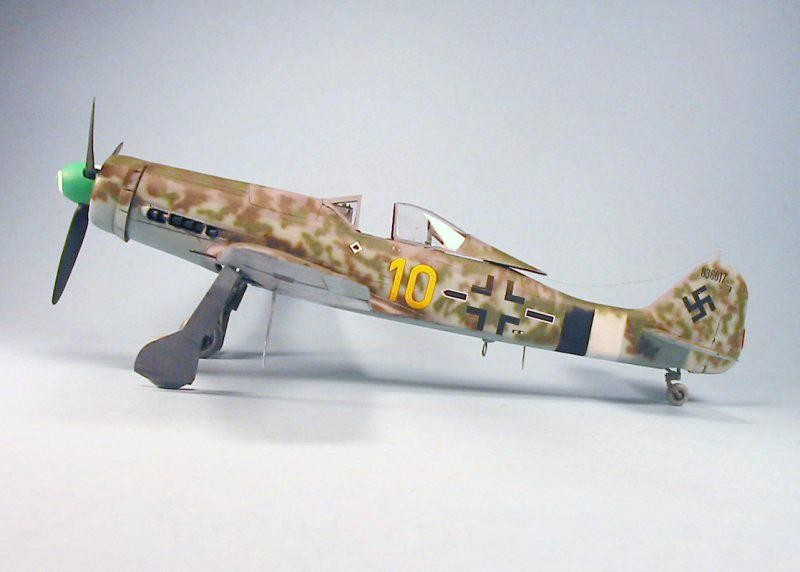

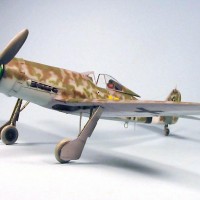
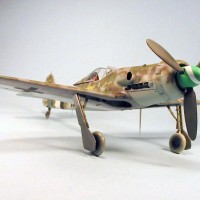
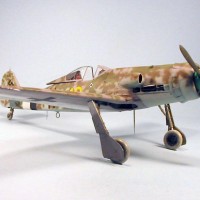
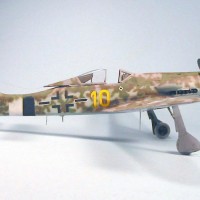
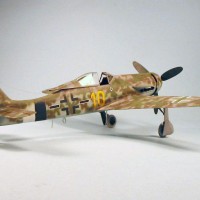
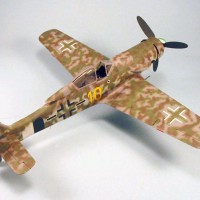
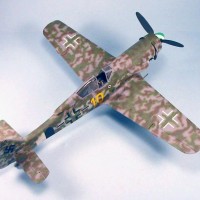
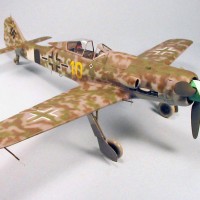
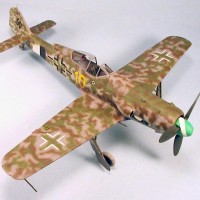
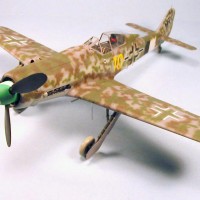
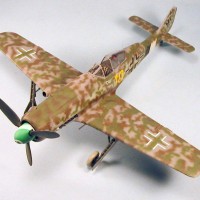
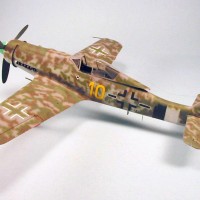
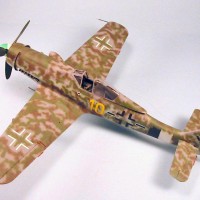
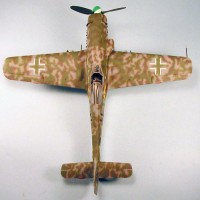
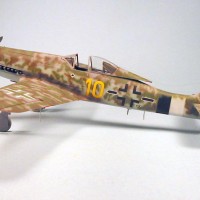

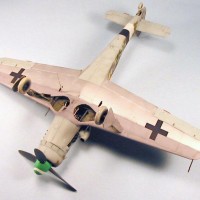
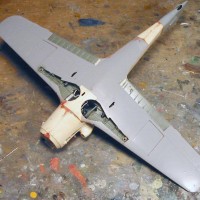

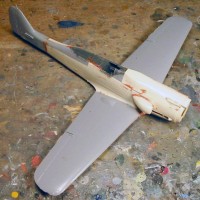
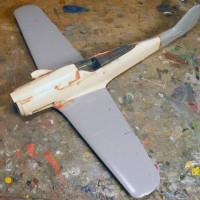
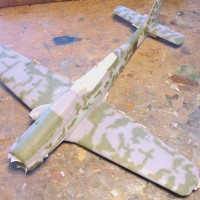
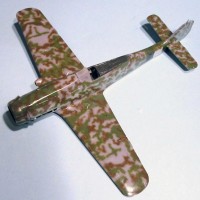
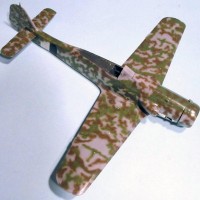

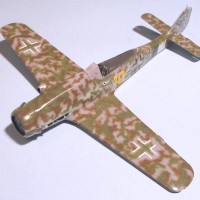
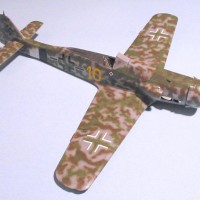
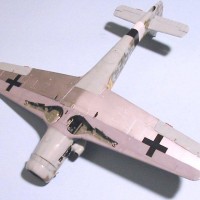
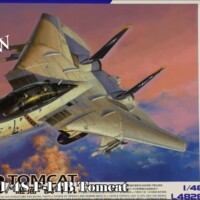
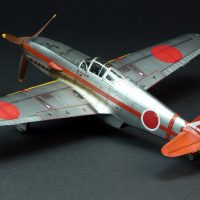
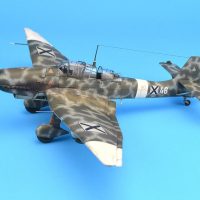
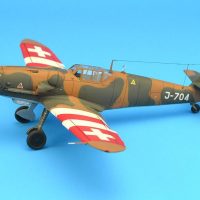
Very nice Dora Tom, amazing paintwork too, kudos!
Tom, I just love the Dora, and the '13' as you say, is one of the best looking and elegant aircraft of the generation. Some may disagree but I think the inward/forward cant of the undercarriage just adds to her prettiness. Thanks for including the partial build shots and paint advice; I've built this kit before and really enjoyed it; it won't be the last.
The history lesson and background, as always, was fascinating.
Nicely finished, painted and photographed, TC.
Beautifully built, finished and photographed, Tom. Great history lesson, too.
Tom fantastic job again! Top notch fantastic finish. You do a great job with the German Camos.
Love getting a compliment from someone whose work I so admire.
Lovely paint work. It looks awesome and that conversion, though from the reading sounded hard, just turned out extremely well. No one can tell that the kit isn’t a D-13 devoted plastic production unless you show the construction pics. Congratulations Tom!
I love that paint job. I’ve got to get around to doing my Eduard 1/48 D-13.
Here's Eduard's D-13 as Yellow 10.
1 attached image. Click to enlarge.
Here's my first D-13 - the Wurger Mechanic conversion of the Dragon D-9 as Yellow 10.
1 attached image. Click to enlarge.
Just about my favourite aircraft of all time - and what a great job - the painting is spectacular.
Hi Tom, wonderful build! Looks so much like Yellow 10 which I was able to visit a couple of years back. She is however, no longer at the Museum of Flight, but at The Flying Heritage Museum up in Everett. A great collection of aircraft there if you ever get the chance to see it.
http://www.flyingheritage.com/Explore/The-Collection/Germany/Focke-Wulf-Fw-190-D-13-(Dora).aspx
Hmm maybe the link doesn't work, lets try again Ok then go here and view the collection!
http://www.flyingheritage.com/
Paul Allen's taking it on himself to save them all.
So it would seem. I think the Museum of Flight has a better overall collection, but Paul's collection is still something to see, plus he flies many of them. I haven't made it up to see one of the flight displays though, I always seem to have to work!
On my bucket list.
Neat conversion and lovely paint job.